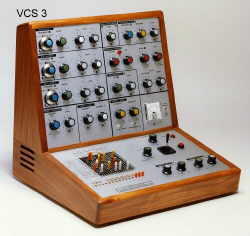
Almost half of the original (1978-82) Storm Bugs recordings were made using a quirky analogue synth called the VCS3. The VCS3, which is still being made by EMS down in deepest Cornwall, is a particularly British creation. Early models of the VCS were Heath Robinson affairs put together using cast off components found in post war army surplus shops in London. One of these components was the patching matrix, something that is unique to the EMS.
Other (mostly American) synths such as the Moog used a linear patching system. In a linear set up modules are connected in a chain. So one jack lead would connect the oscillator output to the filter input and then another lead would take the output from the filter to the ring modulator and then another lead…. and so on. Even the most simple of patches ends up looking like a vintage telephone exchange, with a tangle of jack plugs covering the face of the synth. Whilst visually this effect is quite pleasing it is a little impractical and in a way intellectually limiting.
The VCS3’s matrix system on the other hand is essentially a grid in which a connection between two modules is made by the simple act of inserting a pin. The pin then connects the y with the x-axis. Thus what would be a two-ended cable is replaced by one dot on the grid. This simplicity has an advantage well beyond mere tidiness however. Many users of the VCS3 have commented on how the patch matrix allows one to connect anything to everything, but more importantly what the VCS3 patching system does is encourage the user to think laterally and see a patch not as a series of discrete linear routings but as a totality that opens outwards from the patch bay. At a glance one can see for example that oscillator three is not only being fed into the filter, but is also controlling the voltage of oscillator two, and the amount of reverb being applied to oscillator one and so on. As a VCS3 user one quickly builds up a mental picture of a patch that allows complex changes to be made quickly across a number of variables almost simultaneously. The effect is rather like thinking in three dimensions. This explains why a rather modestly equipped synth such as the VCS3 seems to be able to produce a far greater range of sounds than modular synths with modules aplenty.

The complexity of cabling required for even simple patches means that the Moog soon replaced its cabling system with hardwired design for synths such as the commercially orientated Minimoog. The antithesis of the freethinking encouraged by the VCS3 the Minmoog made it easy to access a smaller palette of sounds quickly (useful when playing live). Crucially the Minmoog has a built in keyboard and combined with the ease of use (i.e. limited functionality) this made it an instrument that appealed to organ players keen to enhance their sounds. The VCS3 was a standalone instrument; a keyboard was available but was not an integral part of the instrument and often seemed to get in the way of creative patching.

Perhaps because of its keyboard unfriendliness, the VCS3 has sometimes been dismissed as a sound effects or weird noise generator, and even by Wendy Carlos as a toy, which misses the point that electronic music was never meant to be about interval and key and all that other well tempered nonsense. The matrix patch bay of the VCS3 make this an instrument for electronic composition, the patchbay is in effect the keyboard and a complex patch the score, the time variable being supplied by the rising and falling of the oscillators and envelope signals. The VCS3 was the first and still curiously one of the few true electronic instruments.
No comments:
Post a Comment